NUR3101: Impact of Nursing Practice on Hypertension in Europe
VerifiedAdded on 2022/08/22
|8
|2630
|10
Report
AI Summary
This report analyzes public health care in Europe, focusing on hypertension as a major health issue. It examines the impact of nursing practice on individuals, communities, and populations, considering social determinants of health, epidemiological studies, and the role of primary care nurses. The report highlights the prevalence of hypertension in Europe, discusses relevant social determinants, and explores epidemiological studies conducted to understand hypertension. It emphasizes the role of primary care nurses in addressing hypertension through various interventions, including BP monitoring, non-pharmacological interventions, and social care interventions. The report also underscores the importance of cultural competence in providing effective care and improving health outcomes for patients with hypertension. The assignment uses references to support the arguments and evidence for the claims. The report concludes that primary care nurses play a critical role in managing hypertension in Europe.
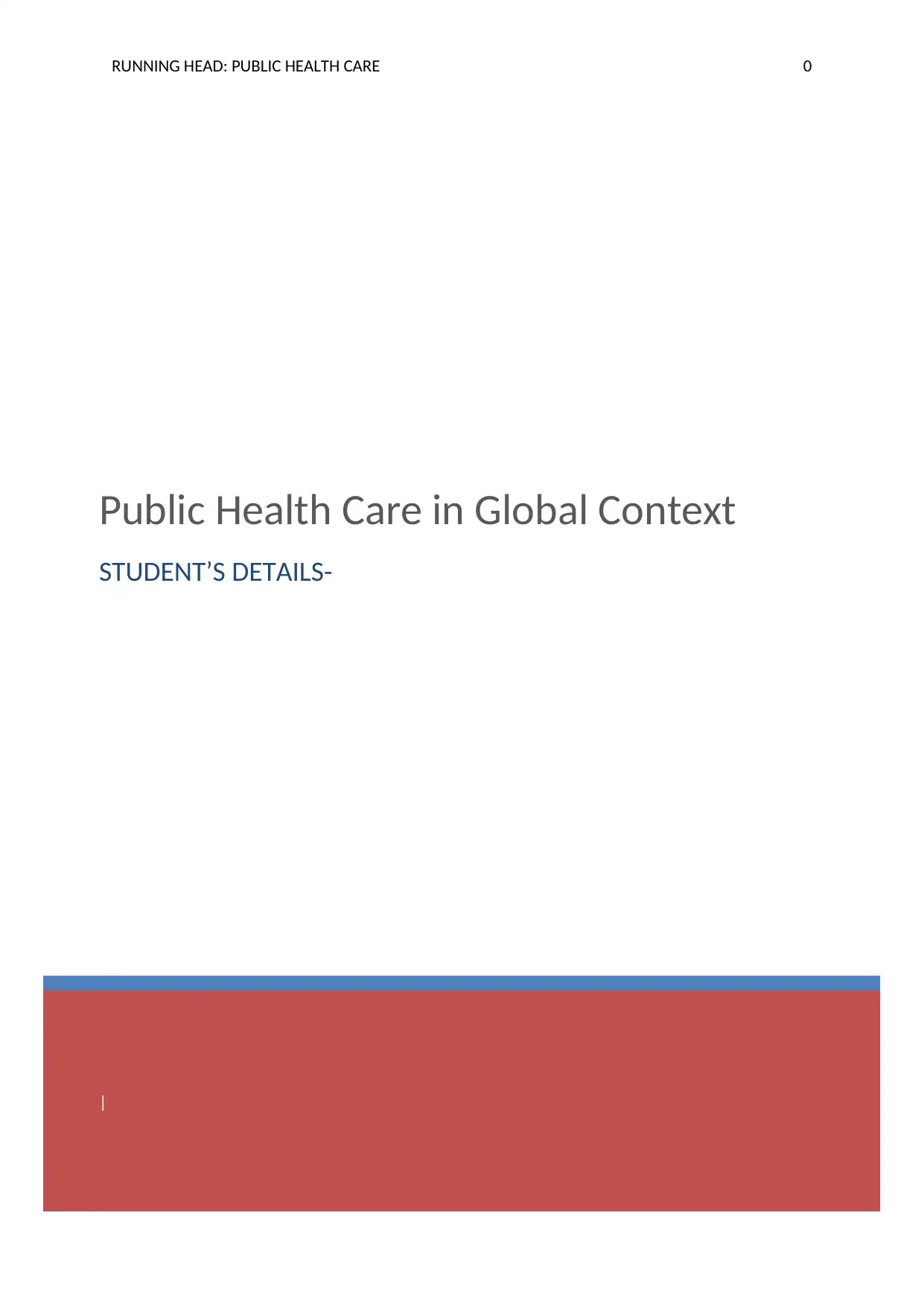
|
Public Health Care in Global Context
STUDENT’S DETAILS-
RUNNING HEAD: PUBLIC HEALTH CARE 0
Public Health Care in Global Context
STUDENT’S DETAILS-
RUNNING HEAD: PUBLIC HEALTH CARE 0
Paraphrase This Document
Need a fresh take? Get an instant paraphrase of this document with our AI Paraphraser
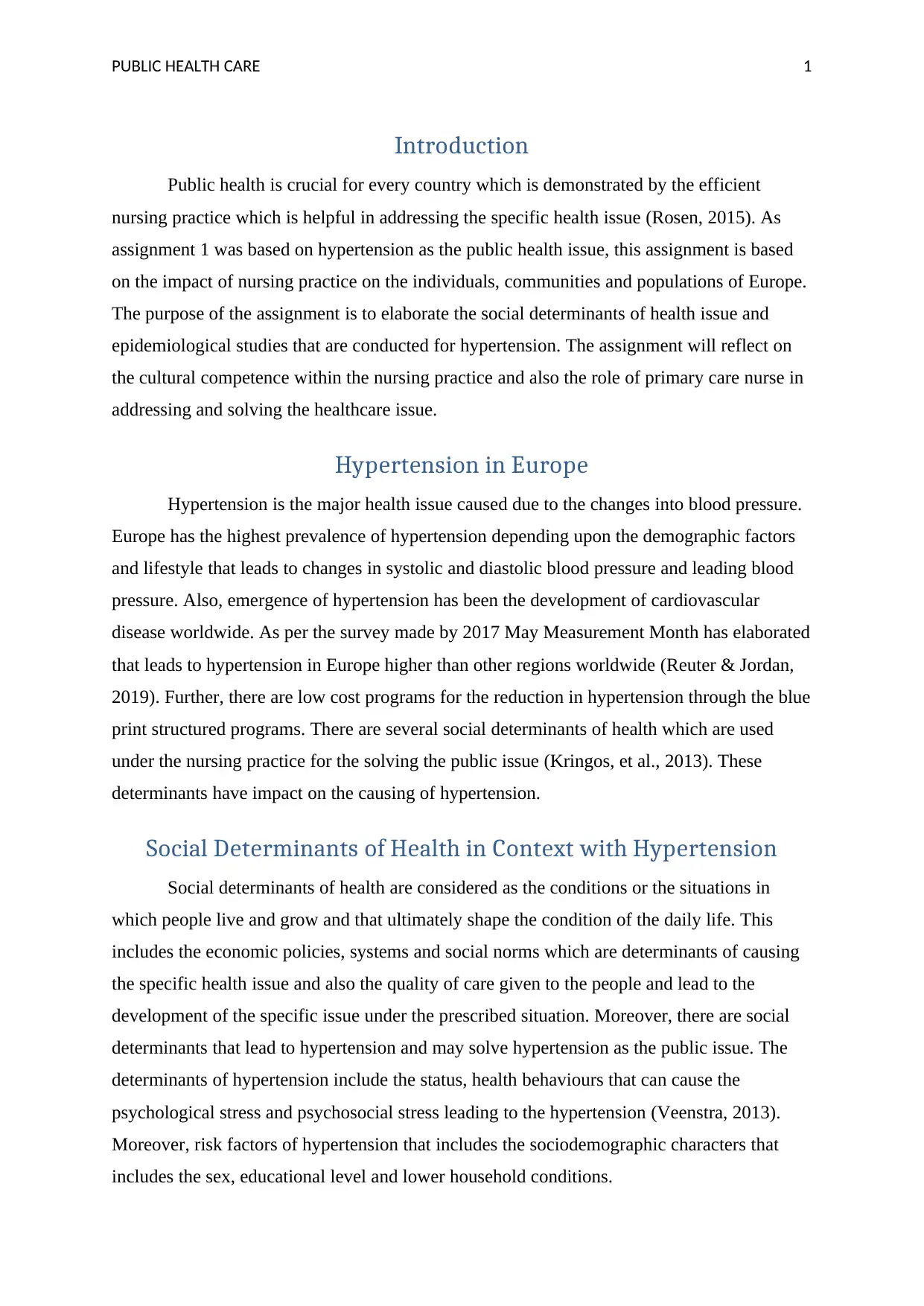
PUBLIC HEALTH CARE 1
Introduction
Public health is crucial for every country which is demonstrated by the efficient
nursing practice which is helpful in addressing the specific health issue (Rosen, 2015). As
assignment 1 was based on hypertension as the public health issue, this assignment is based
on the impact of nursing practice on the individuals, communities and populations of Europe.
The purpose of the assignment is to elaborate the social determinants of health issue and
epidemiological studies that are conducted for hypertension. The assignment will reflect on
the cultural competence within the nursing practice and also the role of primary care nurse in
addressing and solving the healthcare issue.
Hypertension in Europe
Hypertension is the major health issue caused due to the changes into blood pressure.
Europe has the highest prevalence of hypertension depending upon the demographic factors
and lifestyle that leads to changes in systolic and diastolic blood pressure and leading blood
pressure. Also, emergence of hypertension has been the development of cardiovascular
disease worldwide. As per the survey made by 2017 May Measurement Month has elaborated
that leads to hypertension in Europe higher than other regions worldwide (Reuter & Jordan,
2019). Further, there are low cost programs for the reduction in hypertension through the blue
print structured programs. There are several social determinants of health which are used
under the nursing practice for the solving the public issue (Kringos, et al., 2013). These
determinants have impact on the causing of hypertension.
Social Determinants of Health in Context with Hypertension
Social determinants of health are considered as the conditions or the situations in
which people live and grow and that ultimately shape the condition of the daily life. This
includes the economic policies, systems and social norms which are determinants of causing
the specific health issue and also the quality of care given to the people and lead to the
development of the specific issue under the prescribed situation. Moreover, there are social
determinants that lead to hypertension and may solve hypertension as the public issue. The
determinants of hypertension include the status, health behaviours that can cause the
psychological stress and psychosocial stress leading to the hypertension (Veenstra, 2013).
Moreover, risk factors of hypertension that includes the sociodemographic characters that
includes the sex, educational level and lower household conditions.
Introduction
Public health is crucial for every country which is demonstrated by the efficient
nursing practice which is helpful in addressing the specific health issue (Rosen, 2015). As
assignment 1 was based on hypertension as the public health issue, this assignment is based
on the impact of nursing practice on the individuals, communities and populations of Europe.
The purpose of the assignment is to elaborate the social determinants of health issue and
epidemiological studies that are conducted for hypertension. The assignment will reflect on
the cultural competence within the nursing practice and also the role of primary care nurse in
addressing and solving the healthcare issue.
Hypertension in Europe
Hypertension is the major health issue caused due to the changes into blood pressure.
Europe has the highest prevalence of hypertension depending upon the demographic factors
and lifestyle that leads to changes in systolic and diastolic blood pressure and leading blood
pressure. Also, emergence of hypertension has been the development of cardiovascular
disease worldwide. As per the survey made by 2017 May Measurement Month has elaborated
that leads to hypertension in Europe higher than other regions worldwide (Reuter & Jordan,
2019). Further, there are low cost programs for the reduction in hypertension through the blue
print structured programs. There are several social determinants of health which are used
under the nursing practice for the solving the public issue (Kringos, et al., 2013). These
determinants have impact on the causing of hypertension.
Social Determinants of Health in Context with Hypertension
Social determinants of health are considered as the conditions or the situations in
which people live and grow and that ultimately shape the condition of the daily life. This
includes the economic policies, systems and social norms which are determinants of causing
the specific health issue and also the quality of care given to the people and lead to the
development of the specific issue under the prescribed situation. Moreover, there are social
determinants that lead to hypertension and may solve hypertension as the public issue. The
determinants of hypertension include the status, health behaviours that can cause the
psychological stress and psychosocial stress leading to the hypertension (Veenstra, 2013).
Moreover, risk factors of hypertension that includes the sociodemographic characters that
includes the sex, educational level and lower household conditions.
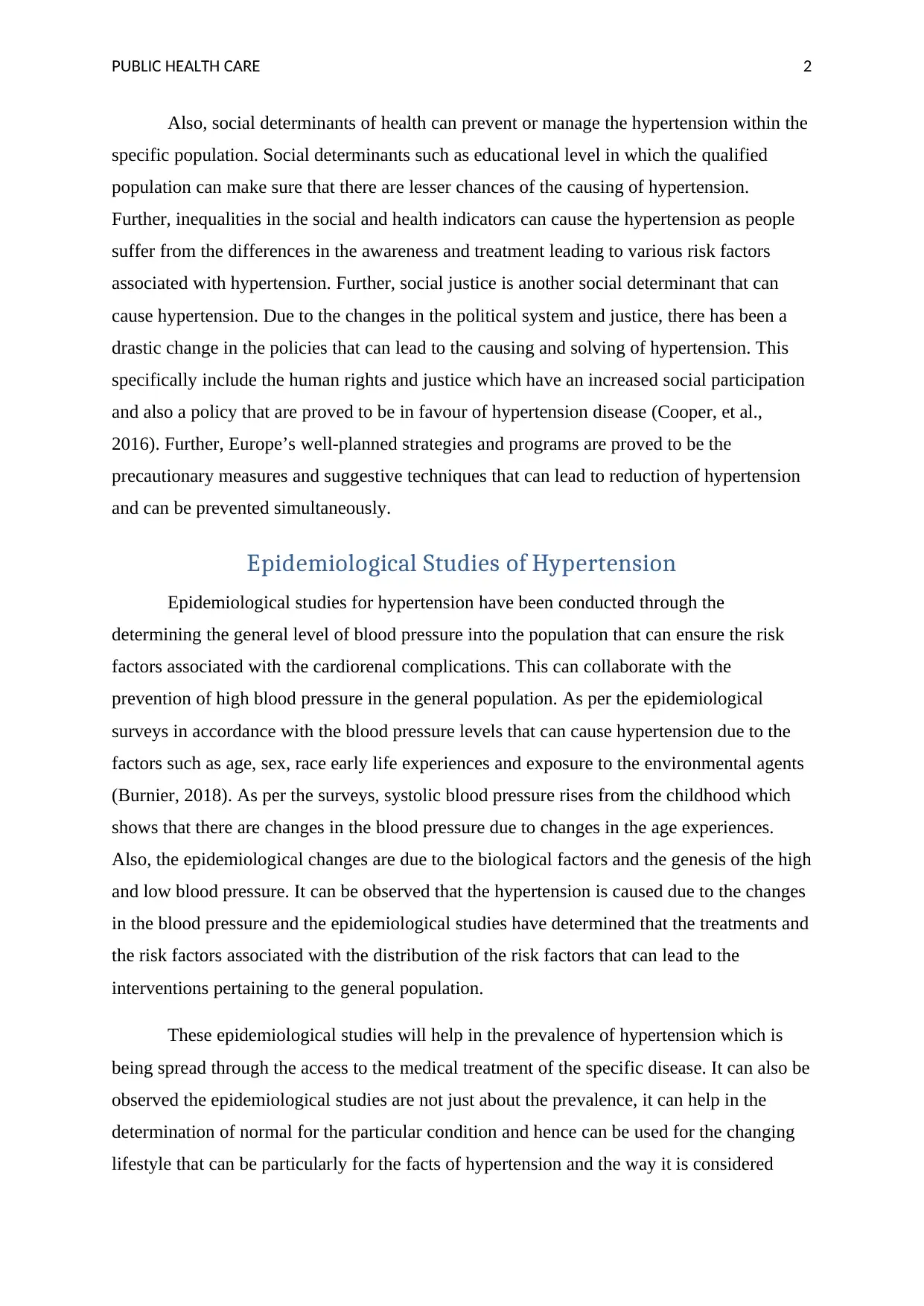
PUBLIC HEALTH CARE 2
Also, social determinants of health can prevent or manage the hypertension within the
specific population. Social determinants such as educational level in which the qualified
population can make sure that there are lesser chances of the causing of hypertension.
Further, inequalities in the social and health indicators can cause the hypertension as people
suffer from the differences in the awareness and treatment leading to various risk factors
associated with hypertension. Further, social justice is another social determinant that can
cause hypertension. Due to the changes in the political system and justice, there has been a
drastic change in the policies that can lead to the causing and solving of hypertension. This
specifically include the human rights and justice which have an increased social participation
and also a policy that are proved to be in favour of hypertension disease (Cooper, et al.,
2016). Further, Europe’s well-planned strategies and programs are proved to be the
precautionary measures and suggestive techniques that can lead to reduction of hypertension
and can be prevented simultaneously.
Epidemiological Studies of Hypertension
Epidemiological studies for hypertension have been conducted through the
determining the general level of blood pressure into the population that can ensure the risk
factors associated with the cardiorenal complications. This can collaborate with the
prevention of high blood pressure in the general population. As per the epidemiological
surveys in accordance with the blood pressure levels that can cause hypertension due to the
factors such as age, sex, race early life experiences and exposure to the environmental agents
(Burnier, 2018). As per the surveys, systolic blood pressure rises from the childhood which
shows that there are changes in the blood pressure due to changes in the age experiences.
Also, the epidemiological changes are due to the biological factors and the genesis of the high
and low blood pressure. It can be observed that the hypertension is caused due to the changes
in the blood pressure and the epidemiological studies have determined that the treatments and
the risk factors associated with the distribution of the risk factors that can lead to the
interventions pertaining to the general population.
These epidemiological studies will help in the prevalence of hypertension which is
being spread through the access to the medical treatment of the specific disease. It can also be
observed the epidemiological studies are not just about the prevalence, it can help in the
determination of normal for the particular condition and hence can be used for the changing
lifestyle that can be particularly for the facts of hypertension and the way it is considered
Also, social determinants of health can prevent or manage the hypertension within the
specific population. Social determinants such as educational level in which the qualified
population can make sure that there are lesser chances of the causing of hypertension.
Further, inequalities in the social and health indicators can cause the hypertension as people
suffer from the differences in the awareness and treatment leading to various risk factors
associated with hypertension. Further, social justice is another social determinant that can
cause hypertension. Due to the changes in the political system and justice, there has been a
drastic change in the policies that can lead to the causing and solving of hypertension. This
specifically include the human rights and justice which have an increased social participation
and also a policy that are proved to be in favour of hypertension disease (Cooper, et al.,
2016). Further, Europe’s well-planned strategies and programs are proved to be the
precautionary measures and suggestive techniques that can lead to reduction of hypertension
and can be prevented simultaneously.
Epidemiological Studies of Hypertension
Epidemiological studies for hypertension have been conducted through the
determining the general level of blood pressure into the population that can ensure the risk
factors associated with the cardiorenal complications. This can collaborate with the
prevention of high blood pressure in the general population. As per the epidemiological
surveys in accordance with the blood pressure levels that can cause hypertension due to the
factors such as age, sex, race early life experiences and exposure to the environmental agents
(Burnier, 2018). As per the surveys, systolic blood pressure rises from the childhood which
shows that there are changes in the blood pressure due to changes in the age experiences.
Also, the epidemiological changes are due to the biological factors and the genesis of the high
and low blood pressure. It can be observed that the hypertension is caused due to the changes
in the blood pressure and the epidemiological studies have determined that the treatments and
the risk factors associated with the distribution of the risk factors that can lead to the
interventions pertaining to the general population.
These epidemiological studies will help in the prevalence of hypertension which is
being spread through the access to the medical treatment of the specific disease. It can also be
observed the epidemiological studies are not just about the prevalence, it can help in the
determination of normal for the particular condition and hence can be used for the changing
lifestyle that can be particularly for the facts of hypertension and the way it is considered
⊘ This is a preview!⊘
Do you want full access?
Subscribe today to unlock all pages.

Trusted by 1+ million students worldwide
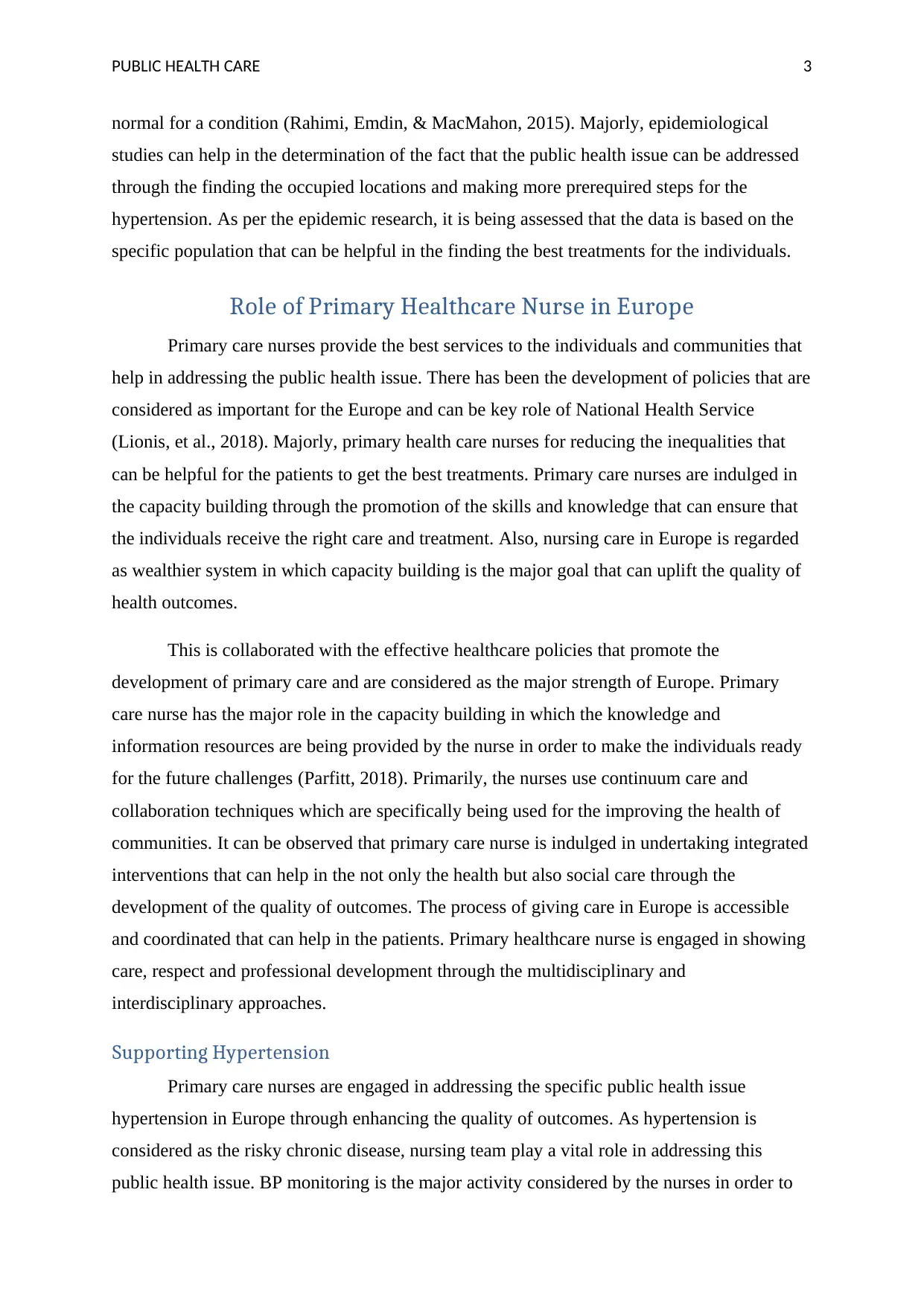
PUBLIC HEALTH CARE 3
normal for a condition (Rahimi, Emdin, & MacMahon, 2015). Majorly, epidemiological
studies can help in the determination of the fact that the public health issue can be addressed
through the finding the occupied locations and making more prerequired steps for the
hypertension. As per the epidemic research, it is being assessed that the data is based on the
specific population that can be helpful in the finding the best treatments for the individuals.
Role of Primary Healthcare Nurse in Europe
Primary care nurses provide the best services to the individuals and communities that
help in addressing the public health issue. There has been the development of policies that are
considered as important for the Europe and can be key role of National Health Service
(Lionis, et al., 2018). Majorly, primary health care nurses for reducing the inequalities that
can be helpful for the patients to get the best treatments. Primary care nurses are indulged in
the capacity building through the promotion of the skills and knowledge that can ensure that
the individuals receive the right care and treatment. Also, nursing care in Europe is regarded
as wealthier system in which capacity building is the major goal that can uplift the quality of
health outcomes.
This is collaborated with the effective healthcare policies that promote the
development of primary care and are considered as the major strength of Europe. Primary
care nurse has the major role in the capacity building in which the knowledge and
information resources are being provided by the nurse in order to make the individuals ready
for the future challenges (Parfitt, 2018). Primarily, the nurses use continuum care and
collaboration techniques which are specifically being used for the improving the health of
communities. It can be observed that primary care nurse is indulged in undertaking integrated
interventions that can help in the not only the health but also social care through the
development of the quality of outcomes. The process of giving care in Europe is accessible
and coordinated that can help in the patients. Primary healthcare nurse is engaged in showing
care, respect and professional development through the multidisciplinary and
interdisciplinary approaches.
Supporting Hypertension
Primary care nurses are engaged in addressing the specific public health issue
hypertension in Europe through enhancing the quality of outcomes. As hypertension is
considered as the risky chronic disease, nursing team play a vital role in addressing this
public health issue. BP monitoring is the major activity considered by the nurses in order to
normal for a condition (Rahimi, Emdin, & MacMahon, 2015). Majorly, epidemiological
studies can help in the determination of the fact that the public health issue can be addressed
through the finding the occupied locations and making more prerequired steps for the
hypertension. As per the epidemic research, it is being assessed that the data is based on the
specific population that can be helpful in the finding the best treatments for the individuals.
Role of Primary Healthcare Nurse in Europe
Primary care nurses provide the best services to the individuals and communities that
help in addressing the public health issue. There has been the development of policies that are
considered as important for the Europe and can be key role of National Health Service
(Lionis, et al., 2018). Majorly, primary health care nurses for reducing the inequalities that
can be helpful for the patients to get the best treatments. Primary care nurses are indulged in
the capacity building through the promotion of the skills and knowledge that can ensure that
the individuals receive the right care and treatment. Also, nursing care in Europe is regarded
as wealthier system in which capacity building is the major goal that can uplift the quality of
health outcomes.
This is collaborated with the effective healthcare policies that promote the
development of primary care and are considered as the major strength of Europe. Primary
care nurse has the major role in the capacity building in which the knowledge and
information resources are being provided by the nurse in order to make the individuals ready
for the future challenges (Parfitt, 2018). Primarily, the nurses use continuum care and
collaboration techniques which are specifically being used for the improving the health of
communities. It can be observed that primary care nurse is indulged in undertaking integrated
interventions that can help in the not only the health but also social care through the
development of the quality of outcomes. The process of giving care in Europe is accessible
and coordinated that can help in the patients. Primary healthcare nurse is engaged in showing
care, respect and professional development through the multidisciplinary and
interdisciplinary approaches.
Supporting Hypertension
Primary care nurses are engaged in addressing the specific public health issue
hypertension in Europe through enhancing the quality of outcomes. As hypertension is
considered as the risky chronic disease, nursing team play a vital role in addressing this
public health issue. BP monitoring is the major activity considered by the nurses in order to
Paraphrase This Document
Need a fresh take? Get an instant paraphrase of this document with our AI Paraphraser
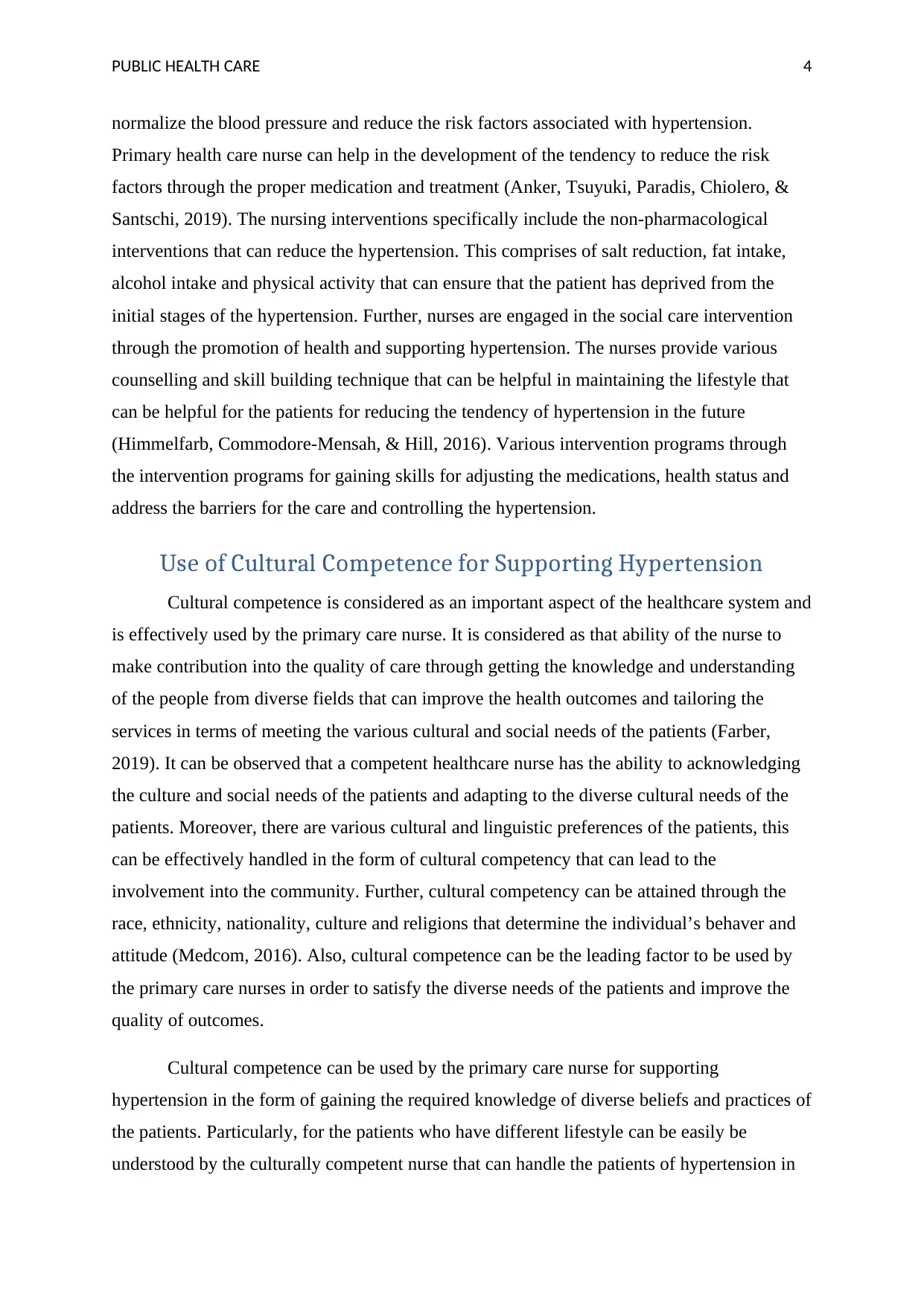
PUBLIC HEALTH CARE 4
normalize the blood pressure and reduce the risk factors associated with hypertension.
Primary health care nurse can help in the development of the tendency to reduce the risk
factors through the proper medication and treatment (Anker, Tsuyuki, Paradis, Chiolero, &
Santschi, 2019). The nursing interventions specifically include the non-pharmacological
interventions that can reduce the hypertension. This comprises of salt reduction, fat intake,
alcohol intake and physical activity that can ensure that the patient has deprived from the
initial stages of the hypertension. Further, nurses are engaged in the social care intervention
through the promotion of health and supporting hypertension. The nurses provide various
counselling and skill building technique that can be helpful in maintaining the lifestyle that
can be helpful for the patients for reducing the tendency of hypertension in the future
(Himmelfarb, Commodore-Mensah, & Hill, 2016). Various intervention programs through
the intervention programs for gaining skills for adjusting the medications, health status and
address the barriers for the care and controlling the hypertension.
Use of Cultural Competence for Supporting Hypertension
Cultural competence is considered as an important aspect of the healthcare system and
is effectively used by the primary care nurse. It is considered as that ability of the nurse to
make contribution into the quality of care through getting the knowledge and understanding
of the people from diverse fields that can improve the health outcomes and tailoring the
services in terms of meeting the various cultural and social needs of the patients (Farber,
2019). It can be observed that a competent healthcare nurse has the ability to acknowledging
the culture and social needs of the patients and adapting to the diverse cultural needs of the
patients. Moreover, there are various cultural and linguistic preferences of the patients, this
can be effectively handled in the form of cultural competency that can lead to the
involvement into the community. Further, cultural competency can be attained through the
race, ethnicity, nationality, culture and religions that determine the individual’s behaver and
attitude (Medcom, 2016). Also, cultural competence can be the leading factor to be used by
the primary care nurses in order to satisfy the diverse needs of the patients and improve the
quality of outcomes.
Cultural competence can be used by the primary care nurse for supporting
hypertension in the form of gaining the required knowledge of diverse beliefs and practices of
the patients. Particularly, for the patients who have different lifestyle can be easily be
understood by the culturally competent nurse that can handle the patients of hypertension in
normalize the blood pressure and reduce the risk factors associated with hypertension.
Primary health care nurse can help in the development of the tendency to reduce the risk
factors through the proper medication and treatment (Anker, Tsuyuki, Paradis, Chiolero, &
Santschi, 2019). The nursing interventions specifically include the non-pharmacological
interventions that can reduce the hypertension. This comprises of salt reduction, fat intake,
alcohol intake and physical activity that can ensure that the patient has deprived from the
initial stages of the hypertension. Further, nurses are engaged in the social care intervention
through the promotion of health and supporting hypertension. The nurses provide various
counselling and skill building technique that can be helpful in maintaining the lifestyle that
can be helpful for the patients for reducing the tendency of hypertension in the future
(Himmelfarb, Commodore-Mensah, & Hill, 2016). Various intervention programs through
the intervention programs for gaining skills for adjusting the medications, health status and
address the barriers for the care and controlling the hypertension.
Use of Cultural Competence for Supporting Hypertension
Cultural competence is considered as an important aspect of the healthcare system and
is effectively used by the primary care nurse. It is considered as that ability of the nurse to
make contribution into the quality of care through getting the knowledge and understanding
of the people from diverse fields that can improve the health outcomes and tailoring the
services in terms of meeting the various cultural and social needs of the patients (Farber,
2019). It can be observed that a competent healthcare nurse has the ability to acknowledging
the culture and social needs of the patients and adapting to the diverse cultural needs of the
patients. Moreover, there are various cultural and linguistic preferences of the patients, this
can be effectively handled in the form of cultural competency that can lead to the
involvement into the community. Further, cultural competency can be attained through the
race, ethnicity, nationality, culture and religions that determine the individual’s behaver and
attitude (Medcom, 2016). Also, cultural competence can be the leading factor to be used by
the primary care nurses in order to satisfy the diverse needs of the patients and improve the
quality of outcomes.
Cultural competence can be used by the primary care nurse for supporting
hypertension in the form of gaining the required knowledge of diverse beliefs and practices of
the patients. Particularly, for the patients who have different lifestyle can be easily be
understood by the culturally competent nurse that can handle the patients of hypertension in
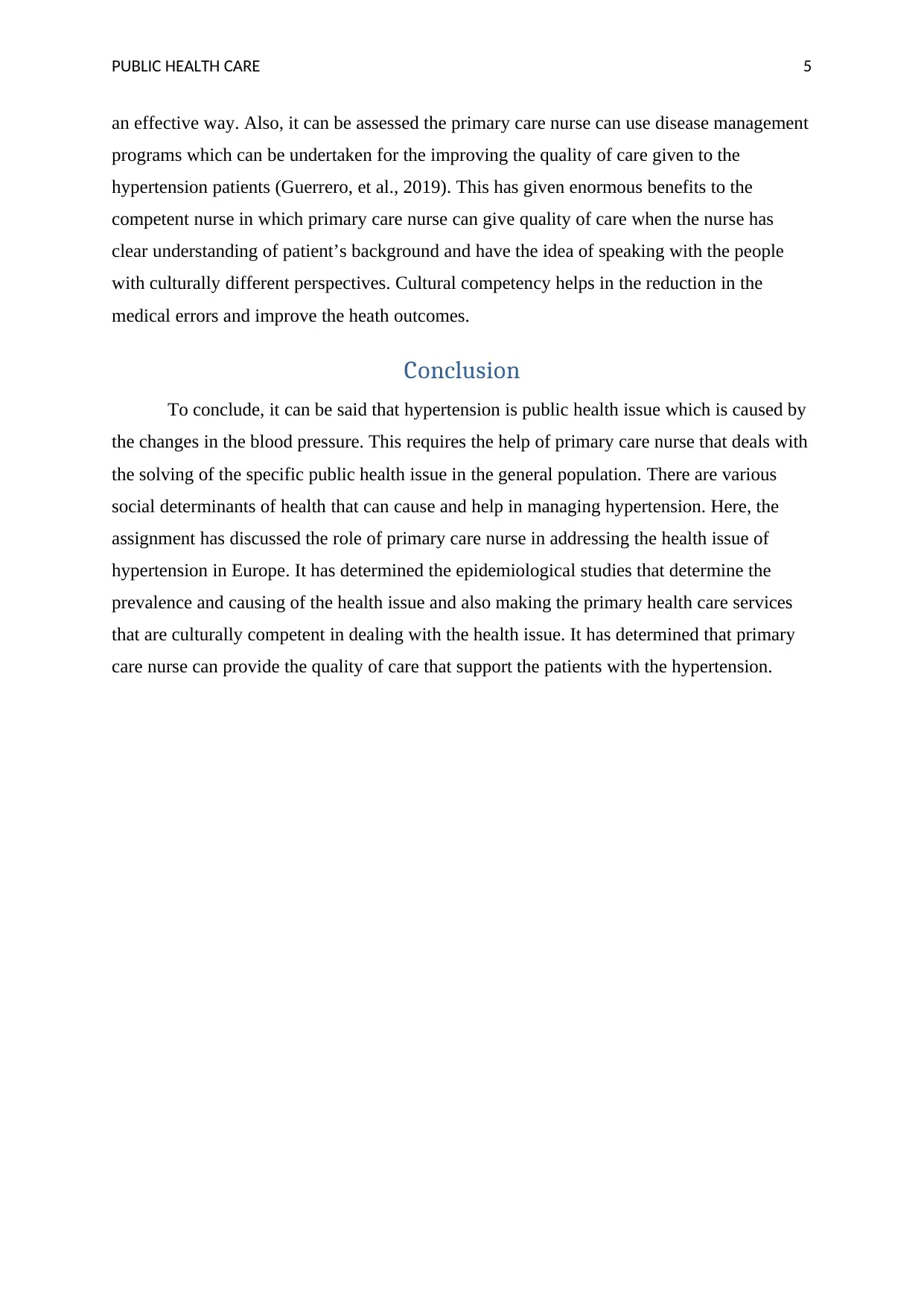
PUBLIC HEALTH CARE 5
an effective way. Also, it can be assessed the primary care nurse can use disease management
programs which can be undertaken for the improving the quality of care given to the
hypertension patients (Guerrero, et al., 2019). This has given enormous benefits to the
competent nurse in which primary care nurse can give quality of care when the nurse has
clear understanding of patient’s background and have the idea of speaking with the people
with culturally different perspectives. Cultural competency helps in the reduction in the
medical errors and improve the heath outcomes.
Conclusion
To conclude, it can be said that hypertension is public health issue which is caused by
the changes in the blood pressure. This requires the help of primary care nurse that deals with
the solving of the specific public health issue in the general population. There are various
social determinants of health that can cause and help in managing hypertension. Here, the
assignment has discussed the role of primary care nurse in addressing the health issue of
hypertension in Europe. It has determined the epidemiological studies that determine the
prevalence and causing of the health issue and also making the primary health care services
that are culturally competent in dealing with the health issue. It has determined that primary
care nurse can provide the quality of care that support the patients with the hypertension.
an effective way. Also, it can be assessed the primary care nurse can use disease management
programs which can be undertaken for the improving the quality of care given to the
hypertension patients (Guerrero, et al., 2019). This has given enormous benefits to the
competent nurse in which primary care nurse can give quality of care when the nurse has
clear understanding of patient’s background and have the idea of speaking with the people
with culturally different perspectives. Cultural competency helps in the reduction in the
medical errors and improve the heath outcomes.
Conclusion
To conclude, it can be said that hypertension is public health issue which is caused by
the changes in the blood pressure. This requires the help of primary care nurse that deals with
the solving of the specific public health issue in the general population. There are various
social determinants of health that can cause and help in managing hypertension. Here, the
assignment has discussed the role of primary care nurse in addressing the health issue of
hypertension in Europe. It has determined the epidemiological studies that determine the
prevalence and causing of the health issue and also making the primary health care services
that are culturally competent in dealing with the health issue. It has determined that primary
care nurse can provide the quality of care that support the patients with the hypertension.
⊘ This is a preview!⊘
Do you want full access?
Subscribe today to unlock all pages.

Trusted by 1+ million students worldwide
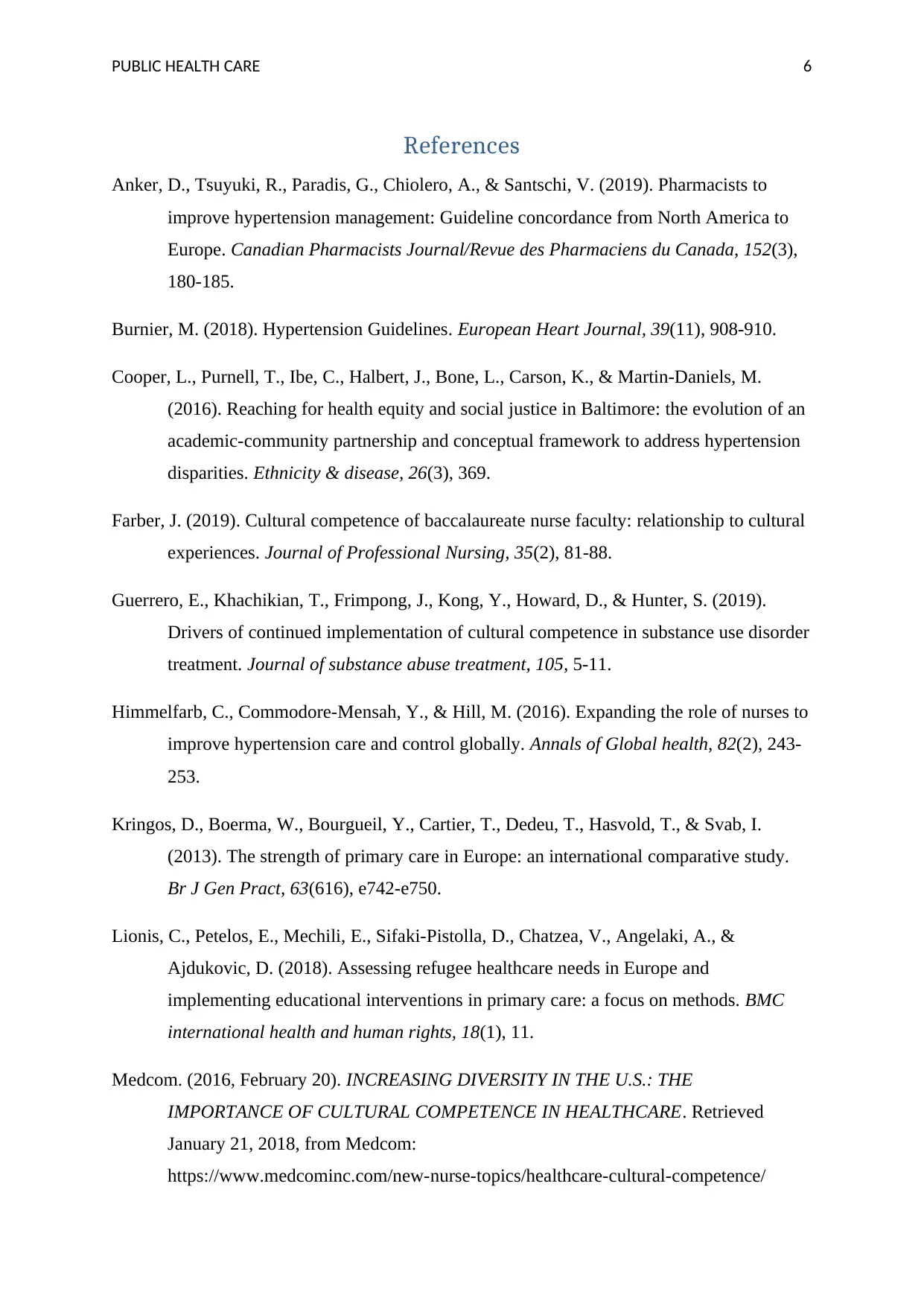
PUBLIC HEALTH CARE 6
References
Anker, D., Tsuyuki, R., Paradis, G., Chiolero, A., & Santschi, V. (2019). Pharmacists to
improve hypertension management: Guideline concordance from North America to
Europe. Canadian Pharmacists Journal/Revue des Pharmaciens du Canada, 152(3),
180-185.
Burnier, M. (2018). Hypertension Guidelines. European Heart Journal, 39(11), 908-910.
Cooper, L., Purnell, T., Ibe, C., Halbert, J., Bone, L., Carson, K., & Martin-Daniels, M.
(2016). Reaching for health equity and social justice in Baltimore: the evolution of an
academic-community partnership and conceptual framework to address hypertension
disparities. Ethnicity & disease, 26(3), 369.
Farber, J. (2019). Cultural competence of baccalaureate nurse faculty: relationship to cultural
experiences. Journal of Professional Nursing, 35(2), 81-88.
Guerrero, E., Khachikian, T., Frimpong, J., Kong, Y., Howard, D., & Hunter, S. (2019).
Drivers of continued implementation of cultural competence in substance use disorder
treatment. Journal of substance abuse treatment, 105, 5-11.
Himmelfarb, C., Commodore-Mensah, Y., & Hill, M. (2016). Expanding the role of nurses to
improve hypertension care and control globally. Annals of Global health, 82(2), 243-
253.
Kringos, D., Boerma, W., Bourgueil, Y., Cartier, T., Dedeu, T., Hasvold, T., & Svab, I.
(2013). The strength of primary care in Europe: an international comparative study.
Br J Gen Pract, 63(616), e742-e750.
Lionis, C., Petelos, E., Mechili, E., Sifaki-Pistolla, D., Chatzea, V., Angelaki, A., &
Ajdukovic, D. (2018). Assessing refugee healthcare needs in Europe and
implementing educational interventions in primary care: a focus on methods. BMC
international health and human rights, 18(1), 11.
Medcom. (2016, February 20). INCREASING DIVERSITY IN THE U.S.: THE
IMPORTANCE OF CULTURAL COMPETENCE IN HEALTHCARE. Retrieved
January 21, 2018, from Medcom:
https://www.medcominc.com/new-nurse-topics/healthcare-cultural-competence/
References
Anker, D., Tsuyuki, R., Paradis, G., Chiolero, A., & Santschi, V. (2019). Pharmacists to
improve hypertension management: Guideline concordance from North America to
Europe. Canadian Pharmacists Journal/Revue des Pharmaciens du Canada, 152(3),
180-185.
Burnier, M. (2018). Hypertension Guidelines. European Heart Journal, 39(11), 908-910.
Cooper, L., Purnell, T., Ibe, C., Halbert, J., Bone, L., Carson, K., & Martin-Daniels, M.
(2016). Reaching for health equity and social justice in Baltimore: the evolution of an
academic-community partnership and conceptual framework to address hypertension
disparities. Ethnicity & disease, 26(3), 369.
Farber, J. (2019). Cultural competence of baccalaureate nurse faculty: relationship to cultural
experiences. Journal of Professional Nursing, 35(2), 81-88.
Guerrero, E., Khachikian, T., Frimpong, J., Kong, Y., Howard, D., & Hunter, S. (2019).
Drivers of continued implementation of cultural competence in substance use disorder
treatment. Journal of substance abuse treatment, 105, 5-11.
Himmelfarb, C., Commodore-Mensah, Y., & Hill, M. (2016). Expanding the role of nurses to
improve hypertension care and control globally. Annals of Global health, 82(2), 243-
253.
Kringos, D., Boerma, W., Bourgueil, Y., Cartier, T., Dedeu, T., Hasvold, T., & Svab, I.
(2013). The strength of primary care in Europe: an international comparative study.
Br J Gen Pract, 63(616), e742-e750.
Lionis, C., Petelos, E., Mechili, E., Sifaki-Pistolla, D., Chatzea, V., Angelaki, A., &
Ajdukovic, D. (2018). Assessing refugee healthcare needs in Europe and
implementing educational interventions in primary care: a focus on methods. BMC
international health and human rights, 18(1), 11.
Medcom. (2016, February 20). INCREASING DIVERSITY IN THE U.S.: THE
IMPORTANCE OF CULTURAL COMPETENCE IN HEALTHCARE. Retrieved
January 21, 2018, from Medcom:
https://www.medcominc.com/new-nurse-topics/healthcare-cultural-competence/
Paraphrase This Document
Need a fresh take? Get an instant paraphrase of this document with our AI Paraphraser
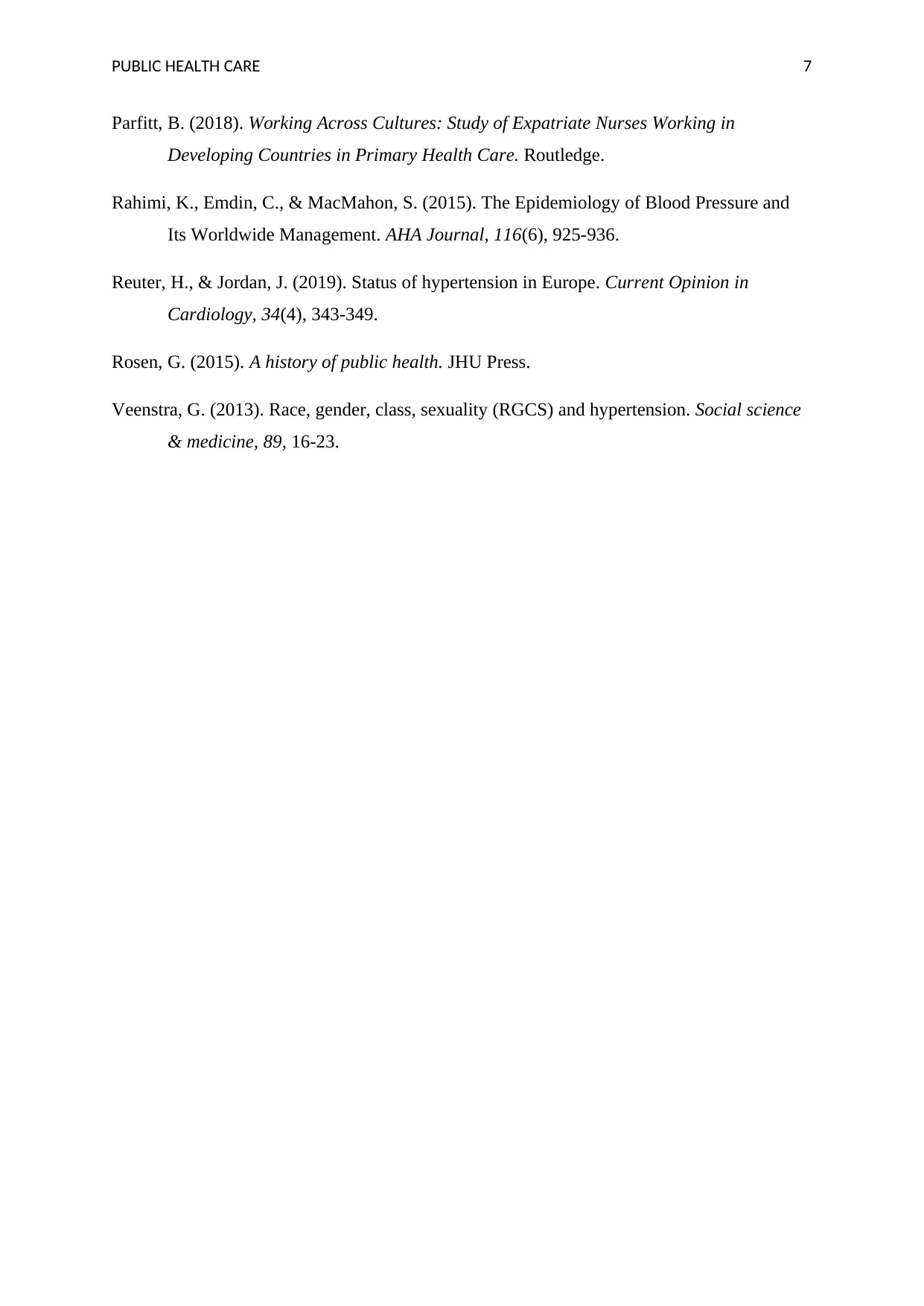
PUBLIC HEALTH CARE 7
Parfitt, B. (2018). Working Across Cultures: Study of Expatriate Nurses Working in
Developing Countries in Primary Health Care. Routledge.
Rahimi, K., Emdin, C., & MacMahon, S. (2015). The Epidemiology of Blood Pressure and
Its Worldwide Management. AHA Journal, 116(6), 925-936.
Reuter, H., & Jordan, J. (2019). Status of hypertension in Europe. Current Opinion in
Cardiology, 34(4), 343-349.
Rosen, G. (2015). A history of public health. JHU Press.
Veenstra, G. (2013). Race, gender, class, sexuality (RGCS) and hypertension. Social science
& medicine, 89, 16-23.
Parfitt, B. (2018). Working Across Cultures: Study of Expatriate Nurses Working in
Developing Countries in Primary Health Care. Routledge.
Rahimi, K., Emdin, C., & MacMahon, S. (2015). The Epidemiology of Blood Pressure and
Its Worldwide Management. AHA Journal, 116(6), 925-936.
Reuter, H., & Jordan, J. (2019). Status of hypertension in Europe. Current Opinion in
Cardiology, 34(4), 343-349.
Rosen, G. (2015). A history of public health. JHU Press.
Veenstra, G. (2013). Race, gender, class, sexuality (RGCS) and hypertension. Social science
& medicine, 89, 16-23.
1 out of 8
Related Documents
Your All-in-One AI-Powered Toolkit for Academic Success.
+13062052269
info@desklib.com
Available 24*7 on WhatsApp / Email
![[object Object]](/_next/static/media/star-bottom.7253800d.svg)
Unlock your academic potential
Copyright © 2020–2025 A2Z Services. All Rights Reserved. Developed and managed by ZUCOL.





